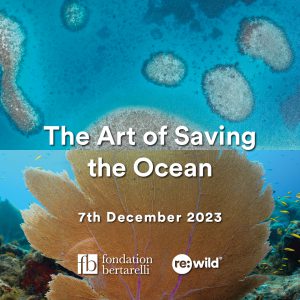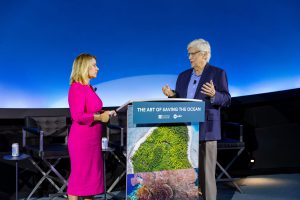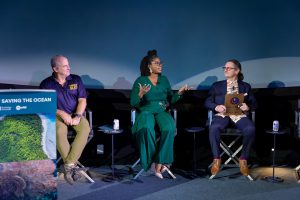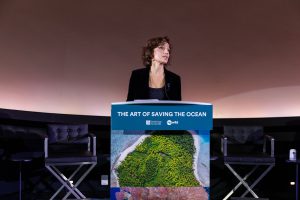The Art of Saving the Ocean

The Art of Saving the Ocean: How Island Restoration Saves People and Nature was a collaborative event between the Bertarelli Foundation Marine Science Programme and Re:wild in an effort to bring discussions of island and ocean conservation to a new audience. This event was hosted at the Phillip and Patricia Frost Museum of Science during Art Basel Miami. Through a series of keynote presentations and panel discussions, we explored the science behind ocean-island connections, learned about projects currently underway and the involvement of local communities, and how we can find new ways to fund this important work.
The Art of Saving the Ocean was designed to bring diverse speakers to diverse audiences. Our panellists ranged from conservation biologists to military veterans; industry leaders in sustainable business development to experts in biodiversity and carbon credits. Our audience hailed from many sectors including scientists, artists, philanthropists, adventurers, astronauts and much more.

The event was opened by Marine Science Programme Lead Heather Koldewey and Re:wild CEO Wes Sechrest, where they welcomed everyone to the day and provided background on the two foundations. Re:wild’s chief conservation officer Russ Mittermeier then took to the stage to explain the importance of establishing and properly monitoring protected areas, especially in biodiversity hotspots. He introduced the themes of the day and made clear what’s at stake if we don’t act to support our natural environments.
In the first session, Ocean-Island Connections, Professor Stuart Sandin laid out the science connecting ocean and island ecosystems, providing examples from his own experience conducting research all around the planet. Then, our panellists discussed how we can better understand these connections in the context of climate change.
 The second session, Rewilding in Action, consisted of two panels. The first panel covered a series of case studies from island and coastal communities currently undertaking rewilding efforts. The second panel then discussed how we can take these examples and scale them up beyond individual islands or archipelagos.
The second session, Rewilding in Action, consisted of two panels. The first panel covered a series of case studies from island and coastal communities currently undertaking rewilding efforts. The second panel then discussed how we can take these examples and scale them up beyond individual islands or archipelagos.
 People and Nature, the third session of the day, began with Francine Madden from the Center for Conservation Peacebuilding who told us about her work mitigating conflict between human and wildlife, and differing communities for the sake of advancing conservation. Then, local community members from Antigua, special forces veterans, and early career scientists, each involved in restoration and rewilding, demonstrated the importance and opportunities for diverse sectors to engage in conservation activities.
People and Nature, the third session of the day, began with Francine Madden from the Center for Conservation Peacebuilding who told us about her work mitigating conflict between human and wildlife, and differing communities for the sake of advancing conservation. Then, local community members from Antigua, special forces veterans, and early career scientists, each involved in restoration and rewilding, demonstrated the importance and opportunities for diverse sectors to engage in conservation activities.
The fourth and final session aimed to answer how we can finance rewilding and restoration work. These two panels discussed how businesses can get involved in restoring biodiversity, and new finance methods on the horizon such as blue bonds and biodiversity credits.
 To close out the day, UNESCO Director General Audrey Azoulay spoke on behalf of the UN Decade of Ocean Science for Sustainable Development. Ms. Azoulay reminded us of the importance of protected areas, and the invaluable interactions between science and local knowledge for the sake of protecting our oceans.
To close out the day, UNESCO Director General Audrey Azoulay spoke on behalf of the UN Decade of Ocean Science for Sustainable Development. Ms. Azoulay reminded us of the importance of protected areas, and the invaluable interactions between science and local knowledge for the sake of protecting our oceans.
To learn more about the event and our panellists, you can download the event programme here – Event Programme – Art of Saving the Ocean
If you missed the event and would like to watch any of the sessions, you can find the recording here:
